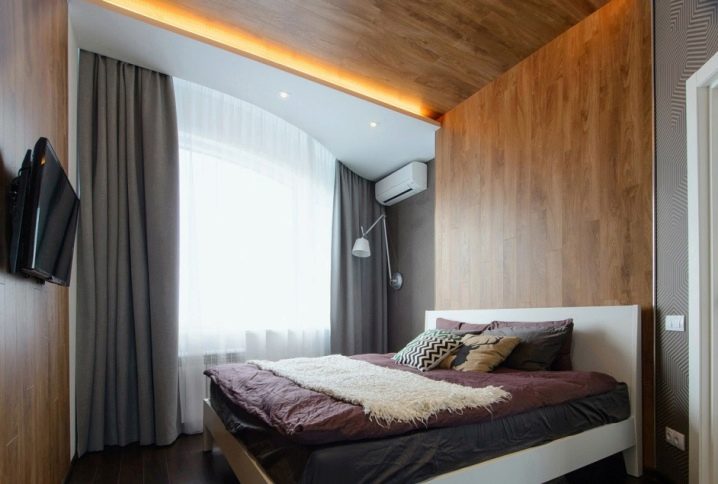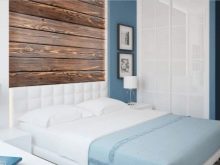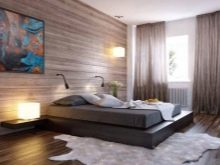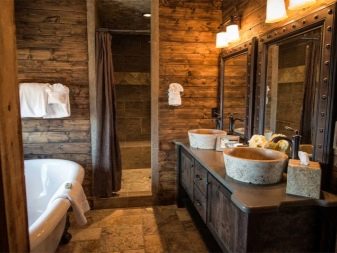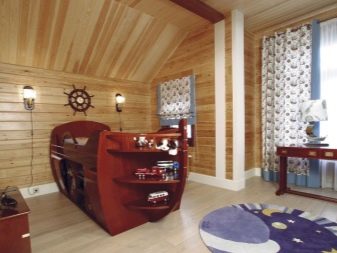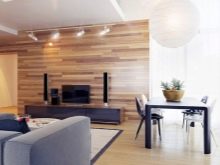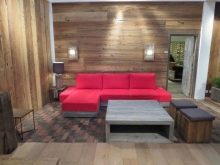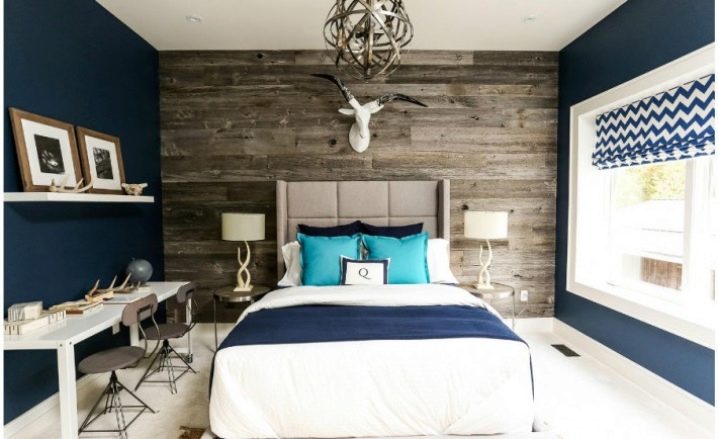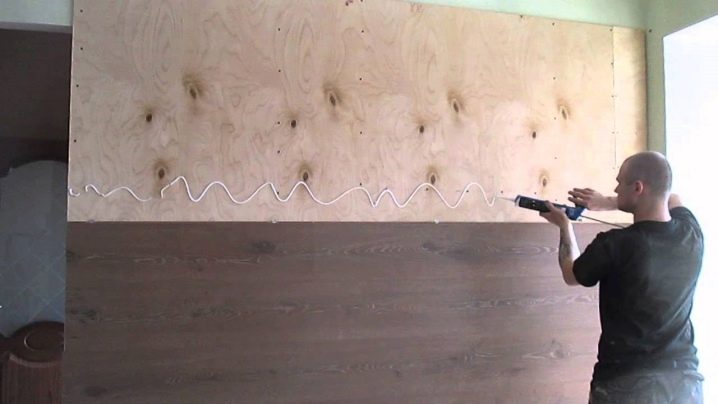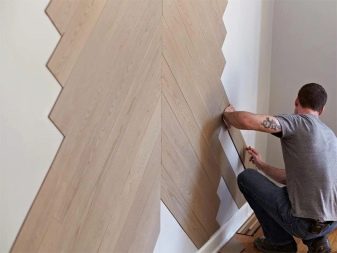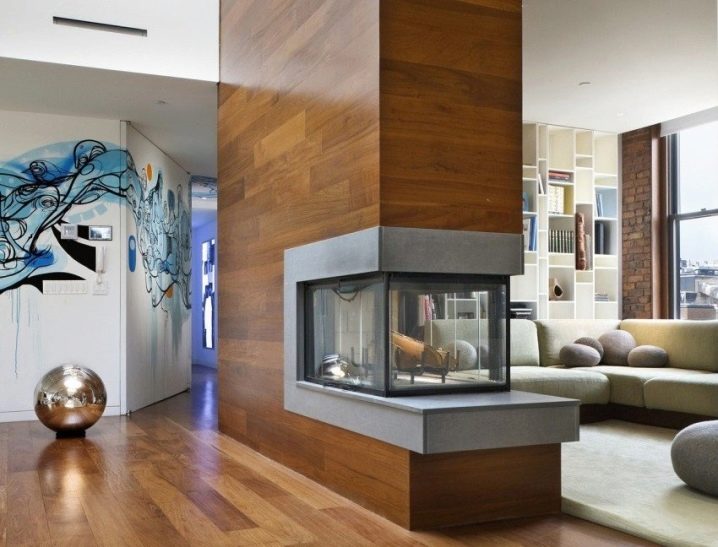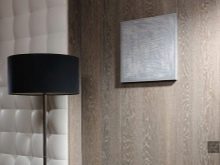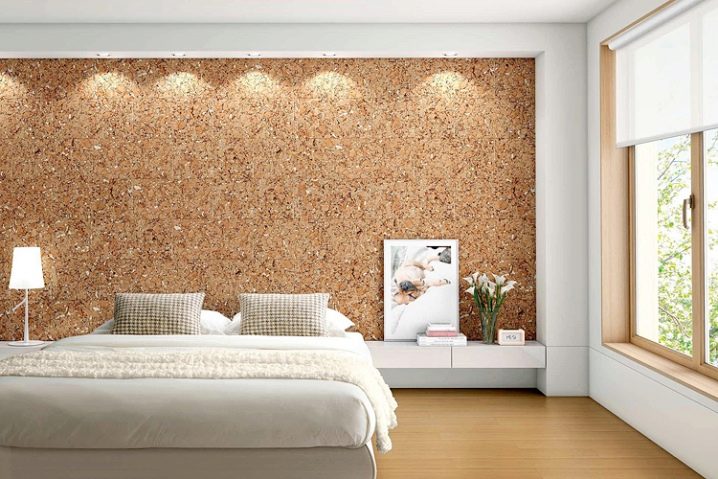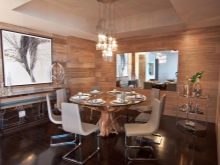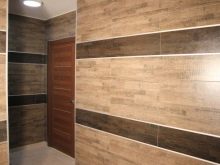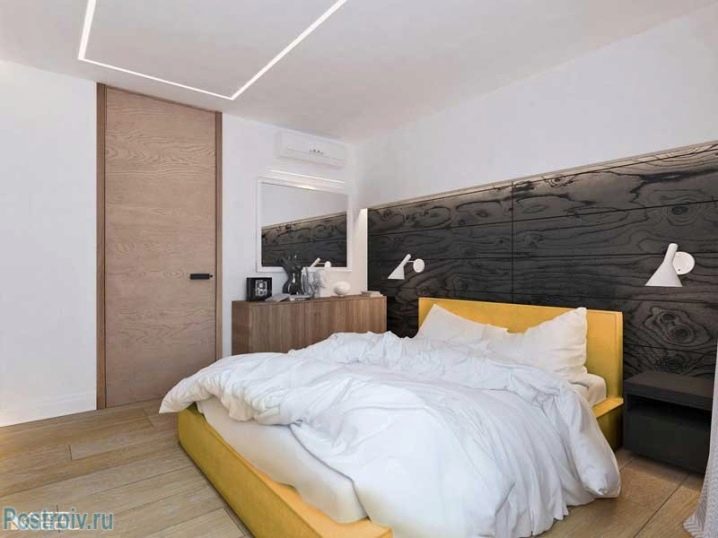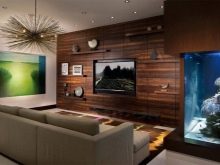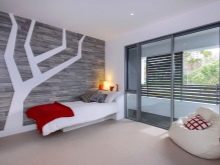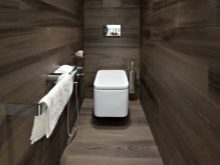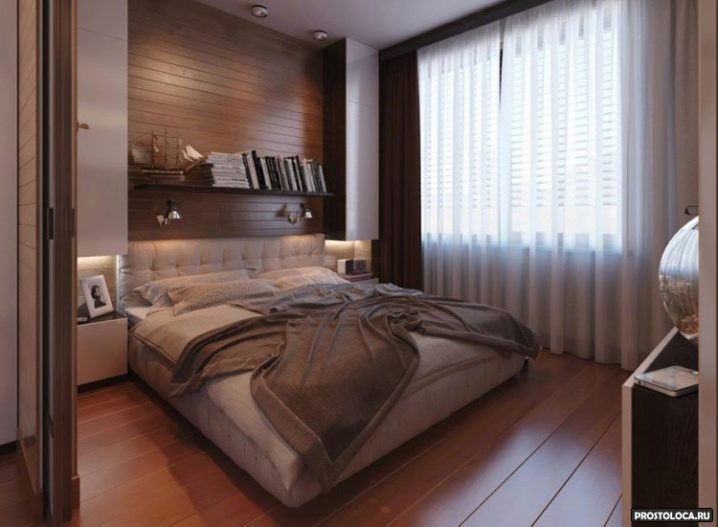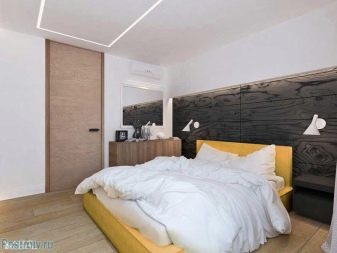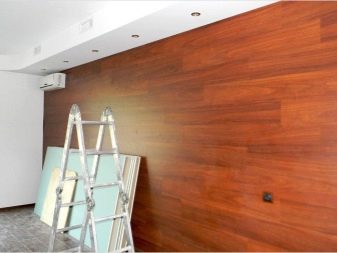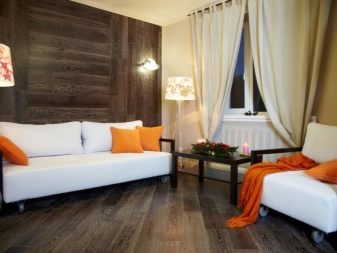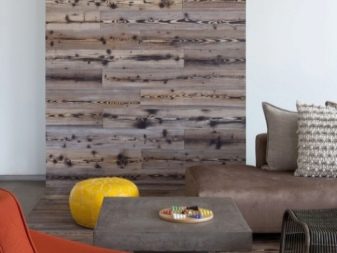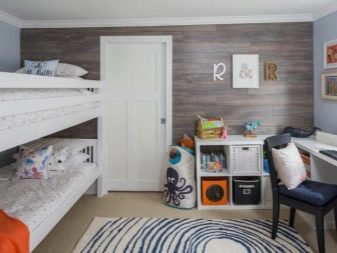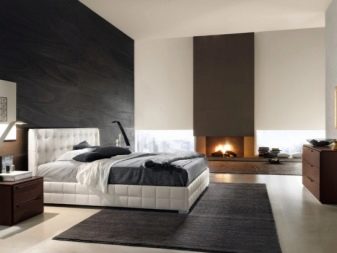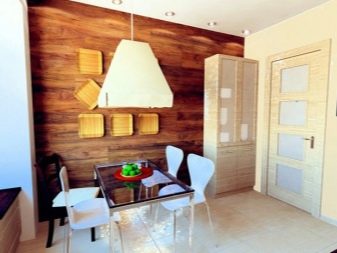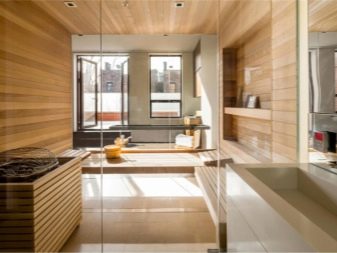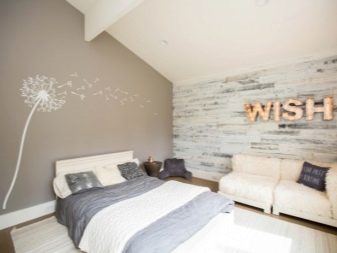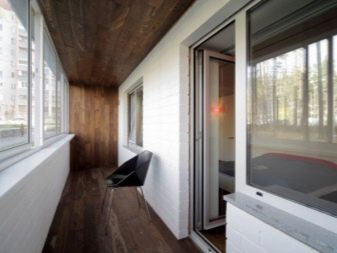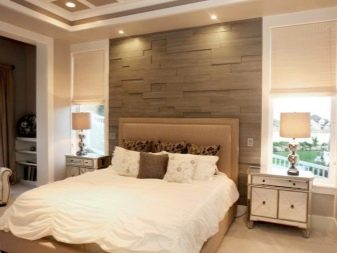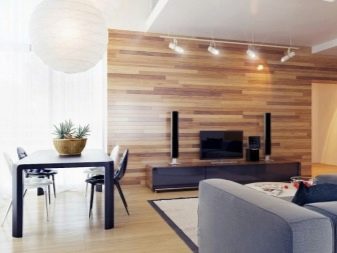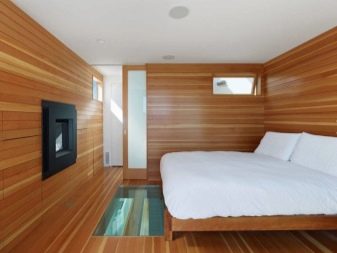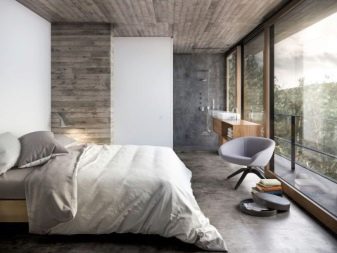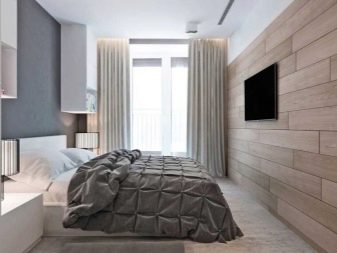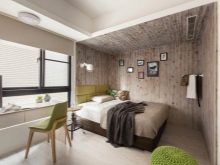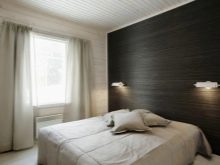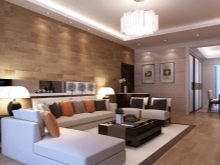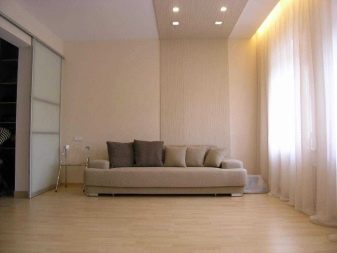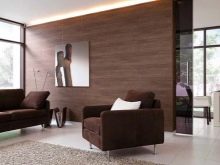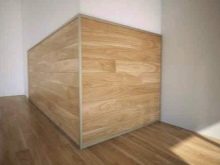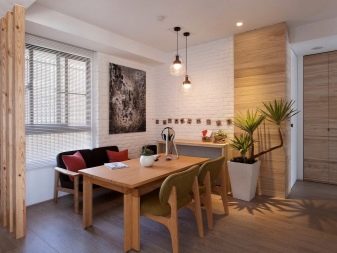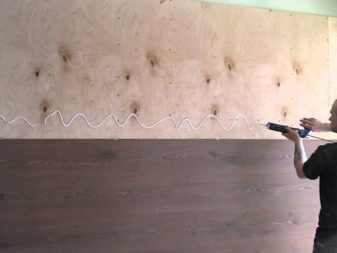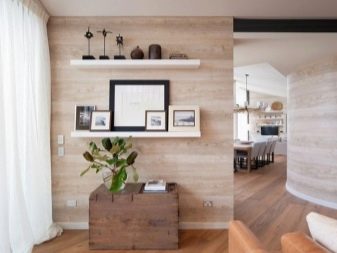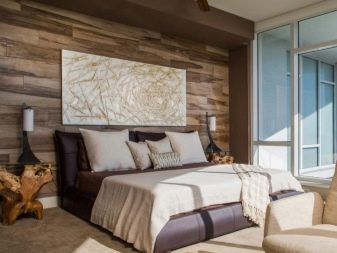Laminate on the wall
Laminate flooring is a modern home décor tool. Today it is in the center of attention of design, being applied to facing of walls. Laminate on the wall - an original method of interior composition, allowing you to show imagination and arrange the room in a special way. To understand the demand for finishing, you need to know its differences, advantages and disadvantages, as well as the way of lining.
What is it?
Laminate flooring is a high-density fibreboard flooring (abbreviated as fiberboard).
Laminate consists of several layers:
- craft paper;
- HDF plates;
- decorative layer;
- top protective film.
The base has resinous impregnation. It protects other layers from temperature and humidity of the room. Protection of the coating can be made on the basis of acrylic or melamine artificial resin. Of these, the second is better, since it provides a greater degree of protection against wear.It is stronger, more reliably protects the surface and the decorative layer from the loss of the original appearance. It is from the film and depends on the classification of laminate, its external data and performance. Based on the presence of graphic additives, the overlay (top layer) is matte or glossy.
The decorative layer is a pattern on the surface of the laminate, which is chosen according to its own preferences. Its texture can be absolutely any, as much as possible imitating different materials (under tile, stone). Moreover, modern technologies make it possible to create a surface with a relief, so it is difficult to outwardly distinguish imitation at first glance. Pattern can be single-lane, two-lane or three-lane. This is important to consider when choosing (for a large area choose the first, for rooms of medium size - the second and for small rooms use the third).
Is it possible to lay on the wall?
There are many options for using laminate. This type of material is not just floor covering. It can be placed on the floor, ceiling, wall. And this is possible due to the different thickness of the material. The methods of wall mounting are different and take into account the peculiarities of the walls, which can be brick or plasterboard.In this case, the walls sheathed with laminate, will look expensive, in no way inferior to expensive wallpaper with a textured surface, whether it is a brick pattern or expensive tiled masonry.
Advantages and disadvantages
Material features consist of its strengths and weaknesses.
The laminate has many advantages, since it:
- easy to install - an inexperienced master or master of the house can handle this job;
- it is biologically inert, therefore it excludes the appearance of the environment for the development of fungus, mold and bacteria;
- it is highly antistatic, does not attract dust and dirt, therefore, is easy to clean and does not provoke allergies;
- durable to use: designed for 10-15 years of service without the need for adjustment;
- to extend the attractiveness of the appearance does not need to be cleaned: for beauty and shine, it is enough to wipe the surface with a damp cloth;
- allows accurate and fast installation on the wall, eliminating the need for exhausting cleaning of dust and debris;
- has high performance characteristics, differing in resistance to accidental mechanical damage and moisture droplets on the surface of the front side;
- it has a wide range of color palette, which allows to satisfy any, even the most demanding customer preferences;
- It is sold in a different format, with a variety of textures, so that there is always an option for sale, taking into account the desired style of the room;
- fits perfectly into the interior composition of different rooms - appropriate in the kitchen, living room, nursery, office, bedroom, hallway, hallway;
- It is a bright accent of the chosen style, therefore it always attracts attention without interrupting the general idea of design;
- not capricious in installation: it can be mounted on the old coating (paint, plaster or remnants of wallpaper that are firmly glued to the wall);
- depending on the number of layers, class and price of the components differs in different prices, so it is quite accessible to the main circle of buyers.
disadvantages
With a lot of advantages and exquisite appearance, the wall laminate has negative aspects.
Being a stylish solution for decorating an apartment, it:
- It is an artificial material that not all customers like;
- cannot create a beautiful surface if the wall under it is not aligned to perfection;
- needs additional costs for the crate (relevant for the castle mounting technique);
- depending on the size and special texture can be expensive, so the installation can turn into a large amount;
- afraid of prolonged stay of water at the joints, therefore, requires mandatory treatment with sealant;
- when flooded apartment swells, can not be restored, therefore, requires replacement.
It is important to keep in mind that finishing laminate in wet areas is impossible. Even if there is no desire to abandon the material and buy moisture-proof material for work, it is worth considering that swelling is just a matter of time. And in this case, you can spend on a much larger amount of raw materials, which will return to the question of facing the wall.
Kinds
Existing types of laminate that meet all safety requirements can be divided into three groups:
- glue;
- sheet piling;
- castle
It is the method of attachment that determines the type of material. Sometimes mounting on the wall seems to be a necessary and difficult task, therefore, in order to understand the specifics of the installation, it is worthwhile to identify the features of each type of laminate:
- Decorative glue The laminate is characterized by smooth edges and has no locks. It consists of separate fragments.They are glued to the wall and interconnected exclusively by means of glue or liquid nails. This installation is simple, but takes time. In terms of dismantling, this laminate is capricious, especially if you need to remove the panels from the wall intact.
- Sheet piling The analogue differs from the adhesive one by the presence of tongue-and-groove locks, which, when connecting parts, form small joints between the panels. The fixation of this laminate takes place in the grooves of the tongue by means of studs or cleats (dry method in which the fragments are joined together at a right angle). This is one of the most convenient types of wall cladding. The work often uses glue, but the locks are not glued.
- Clique the laminate stands out from the background of the previous material by a special, more convenient to use system of fastening panels. In fact, it is an improved modification of sheet piling laminate. The parts are fastened together at an angle of 20 degrees, after which the grooves of the locks are joined, snapping the design. This type of finish needs a crate, although masters often glue the panels together.
Laying technology
Depending on the type of laminate, the method of its installation is different.Glue means putting glue on the panels themselves, then gluing directly to the wall, and the castle one is done with the preliminary preparation of a wooden sheathing (frame) consisting of slats and attached to the wall, and fixing the laminate by means of fastenings.
With a clearly better second method, they often choose the first installation option. This is due to a decrease in the usable area: the decorated castle cover looks beautiful, but at the same time, on each side the room is reduced by several centimeters. The starting point depends on the spatial orientation of the panels. Partial vertical mode is carried out from bottom to top in the direction from left to right, using the building level. When fully trimmed, work is done from the top down from the ceiling. It is important to use plinths and corners in the work, which are able to hide the imperfections of the work, if they are selected in the same tone as the finish. However, you can use contrasting additions.
Colors
The colors of laminated tiles are varied and depend on the specific style. The shade of the material can be a premium light or practical dark.Some canvases are a multi-colored pattern of an abundance of contrasting tones.
Conventionally, the color solutions of the material can be divided into three groups:
- neutral, which includes white, light gray, black shades;
- classical, in which natural wood tones prevail;
- bright, with rich color contrasts.
Styles
The style is also important. The color is selected depending on the characteristics of the particular style solution chosen for the room and the characteristics of the room. If the lighting is insufficient, the shade can not be dark: it will hide the already small luminous flux.
Lighting is important: it will determine the beauty of the wall covering. Combining light color and delicate shades of furnishings, you can bring an illusion of space into the room, using rich colors and the muffled light of lamps, you can give the room solidity and solemnity.
The use of laminate on the wall is somewhat limited: it does not fit vintage and antique styles, but it is appropriate in some classical and modern styles:
- English - it is possible to demonstrate the stiffness and pomposity through a reddish tone with the texture of a noble-wood tree (especially important for the design of a study or a home library);
- Minimalism - an excellent solution: it is worth experimenting with a white glossy or matte colored surface without a complex pattern;
- Loft - an ideal choice: you can demonstrate the deliberate rudeness through the material under the tiled masonry, rough plaster, reviving the walls with stained paintings;
- Ontoart - pretty bold, but possible. The coating of a monochromatic color in the style of minimalism in combination with a natural color palette and high-quality eco-friendly materials and good lighting will look appropriate with the support of ontoart images.
In addition, the laminate is appropriate in areas such as country, Provence, eco, ethno, avant-garde and contemporary. The original technique will be a composition in the neoclassical style, if you take into account the sense of proportion, using cream or pistachio material as the wall decor.
In various rooms
Placing the laminate in different rooms allows you to show imagination and demonstrate a special taste.This decorative finish is not mounted just like this: it is important to choose the right accent place. Installing laminated panels on the wall, it is important to think over the design, choose the style of the interior composition, decide on the type of material and fasteners system.
It is important to think about the features of each room:
- in the living room is appropriate accent in the form of trim panels;
- a spacious room (for example, a hall) can be zoned, highlighting one wall and repeating the finishing in smaller volume on the other;
- standard kitchen solution - making an apron, combining the texture with the facade of the kitchen set;
- in the bedroom you can position the panels at the headboard or accentuate the dressing table area;
- in the hallway, it is advisable to hold a combination with panels or select a dressing area;
- in the corridor, you can decorate part of the wall, distracting attention from the characteristics of the room (for example, projections);
- the loggia can be trimmed completely if it is glazed;
- on the balcony you can sheathe one side in front of the windows: and the view will be exquisite, and resistance to moisture will be more.
With regard to the toilet and bathroom, it is worth noting that the cladding of these rooms with laminate does not make sense, especially if the bathroom is combined. Most of the apartments in these rooms have pipes and there is condensation.Placing laminate in them is not recommended. In the bathroom, the load on the laminated panels is not commensurate with their operational capabilities.
How to choose?
The choice of material begins with the definition of class. The higher it is, the better its performance and thicker protective layer. However, for different walls the need for mounting the material is different. For decorating a bedroom or kitchen, the thinnest laminated tile of class 21, 22, 23 is suitable.
Thickness is selected based on the location of the laminate on the wall. If it is a niche or lower part of the wall, and the laminate will replace plastic panels, it is preferable to choose the raw material thicker. For example, in the hallway the laminate can be exposed to frequent cleansing or the claws of pets, so it is better to refuse to buy thin panels. In addition, thin lining is not suitable for hallways: you need a moisture-resistant version, resistant to rain drops and umbrella spray. It is worth paying attention to the multilayer material with a thick protective film: the abrasion of the laminate will be minimal.
The choice should be carried out in a proven store that has a lot of positive feedback.When buying it is important to inspect each laminated panel: the corners must be perfect, otherwise the marriage will ruin the whole composition. In addition, you need to pay attention to the thickness: under poor storage conditions, the material may become thicker, which will spoil the appearance of the wall covering (the plates may stand out from each other). It is important to make a preliminary calculation of the material. And yet: all the details must be from the same batch, otherwise a different shading is possible, which eliminates the illusion of a solid canvas.
How to finish?
Do-it-yourself laminate wall decoration is a way to feel like a designer. The method of work determines the material itself. Before installation you need to prepare the wall. The working surface must be flat and dry. However, in the case of the crate is not important.
There are plenty of possibilities for design. Placement on the wall must be deliberate, otherwise the overall appearance risks being fragmented and awkward. It is undesirable to use the same material for the walls and the floor: it may seem that the floor began to wrap onto the wall (the laminate rolling from the floor looks extremely ugly). Due to the nature of the material and its shades,the abundance of the same laminate can create a feeling of being in the bath.
Finishing can be done in different ways: vertically, horizontally, diagonally. You can put wall decoration "herringbone", corners. It is perfectly combined with plastic panels, tiles, wallpaper.
The most interesting design solutions that do not violate the harmony of the composition include the following:
- the combination of laminate on the wall at the head of the bed with the support of a similar pattern of flooring (the color of the floor should be slightly darker);
- in the living room, you can highlight the central zone or the area behind the sofa, highlighting it with a contrasting color of the wallpaper and a deliberately dark shade of the floor covering;
- the emphasis can be placed in a checkerboard pattern, creating the illusion of the floorboard, and it’s better if, besides the laminate, the surface is decorated with another material;
- The original design is a plinth with a low panel, visually making the walls higher.
Interior design options
Interior design depends on the possibilities of imagination: it is often possible to combine the incompatible and fit the laminate finish in the most unpredictable environment.To better understand how to make it more harmonious, you can refer to examples of experienced interior stylists.
You can create the illusion of wall space by means of laminate in a strip of light wood color: by placing the accent in the center, highlighting it with plates with a lace pattern and light wallpaper, decorating the wall surface with a picture.
The original recreation area can be created using a monolithic solution: the wall is completely sheathed with laminate, small ledges-shelves are placed on it, they are decorated with objects of their favorite subjects, and the TV is placed in the center (stylishly and unusually).
You can create a special composition using a material of a light beige shade, covering all walls with it: the solution requires bright spots and bright contrasts - you need white curtains, shelves, dark statuettes, photo frames and a floor of a more saturated color.
You can show the beauty of the dining area by activating the coffee color of the material with a matte texture, placing the laminate horizontally across the entire area of the walls: to save the room from boredom, it is better to make the floor dark and glossy, and the furniture - neutral gray with a metallic finish (mirror required).
If there is not enough space for the kitchen area, the exit may be as follows: the accent wall near the dining area is performed in the tone of dark wood, the sides and ceiling are white, the furniture is picked up coarse wood, but the tone is set using red color, using a vase, flowers , ceiling lighting, pattern paintings and furniture facade.
How to put laminate on the wall, see the next video.

